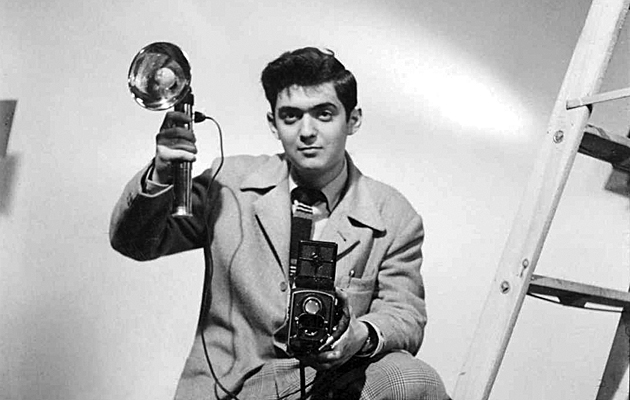|
The young Stanley Kubrick before becoming a professional photographer |
||
|
From spaceship airlocks to hotel floor tiles, the director went to painstaking lengths to create the physical environments of his most famous films, writes Will Wiles We know that Dr Frank Poole’s gravity-defying centrifugal jog around the bright, white, habitat ring of the spaceship Discovery in Stanley Kubrick’s film 2001: A Space Odyssey (1968) is an illusion. Of course it is. And it’s not so hard to guess at the pre-CGI mechanical trick used to create the illusion – not even a new trick, but the same method Fred Astaire uses to dance from floor, to wall, to ceiling in Royal Wedding (1951). But it’s still a bit of a shock to see it: the whole of that gleaming set suspended in a dark, workmanlike timber scaffold like a giant hamster wheel, so the surroundings can move while Poole runs in place. The Discovery illusion is convincing because the environment is convincing: Discovery looks solid, rational, like it should work. Its plausibility is seductive. Stanley Kubrick: New Perspectives, a small exhibition at the Work gallery in King’s Cross, London, finds its new perspectives by focusing hard on the environments this consummate filmmaker crafted for three of his most famous films. Crafted is very much the word. Both in front of and behind the camera, Kubrick was the master of technical detail. We get a taste of the painstaking research that went into every detail of 2001: A long letter from the author Arthur C Clarke (who co-wrote the screenplay) lays out precise specifications for airlock design. Delivery schedules show when different companies can provide their prototypes for use on the set – a credit card from American Express, for instance, on screen for merest seconds. You get the sense that Kubrick is not simply trying to create a plausible and pleasing view of the future. Rather he appears to be earnestly trying to establish what the future will be, for certain, striving for total realism even in the as-yet-unrealised. He is acting like a one-man think tank, assembling experts, interrogating them, pinning things down. “We are badly in need of a mad computer expert who can be around and advise on dialogue and jargon to use in computer scenes,” he writes in a letter among the exhibits. “It should be someone who has his eye on the future of computers and not just a stick-in-the-mud type. Maybe IBM could assign someone?”
The collection of essays makes extensive use of the Stanley Kubrick Archive For The Shining (1980), the interiors of the haunted Overlook hotel are assembled as detailed cardboard maquettes, photographs, and then given psychological annotations. “Does this look like it goes to the lounge? You feel the exit direction is [toward the viewer].” There are colour photographs of the lobby, lounge and corridor spaces of the Ahwanhee hotel in California, the inspiration for the cavernous halls and bold native American decor of the Overlook, and a letter from production designer Roy Walker accompanied by notes that bring home the attention to every tiny facet of the space: “Mezzanine over small lounge no. 1: overall sizes. Floor tile sizes. Door sizes. Balustrade details. Electrical fittings & switches.” No wonder the Overlook became the mesmeric screen presence that it is. By contrast the conversion of the mid-demolition Beckton gas works in east London into the war-torn Vietnamese city of Hue for Full Metal Jacket (1987) is revealed as a clever light-touch exercise. A smattering of palm trees, local adverts and architectural details are enough “to believably represent the Vietnamese landscape, while also evoking generic urban warfare”. Kubrick’s concern was that the site was not enough of a mess. I understand the large smokestacks are going to come down this Sunday,” he writes in a 1984 letter. “If it’s possible I’d like to leave the rubble there at least until we have finished filming. The place has been cleaned up a bit too much and the extra debris would come in handy. Is that possible?” The exhibition is tied to the publication of a new collection of critical essays about Kubrick, also called Stanley Kubrick: New Perspectives. Sadly at the time of the preview the book was not available; it is expected in September. |
Words Will Wiles
Images: Black Dog Publishing; courtesy Stanley Kubrick film archive LLC and University of the Arts London
Stanley Kubrick: New Perspectives
Stanley Kubrick: New Perspectives |
|
|
||



















